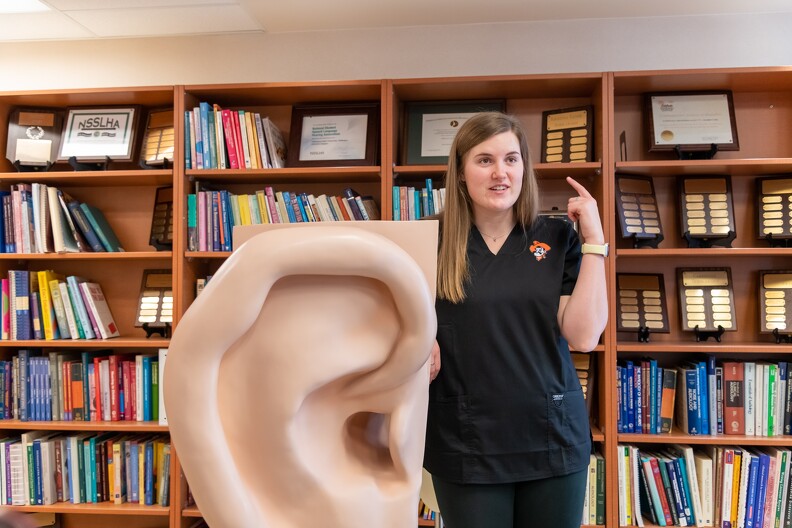11.4 Why Listening Is Difficult
Click below to play an audio file of this section of the chapter sponsored by the Women for OSU Partnering to Impact grant.

At times, everyone has difficulty staying completely focused during a lengthy presentation. We can sometimes have difficulty listening to even relatively brief messages. Some of the factors that interfere with good listening might exist beyond our control, but others are manageable. It’s helpful to be aware of these factors so that they interfere as little as possible with understanding the message.
Noise
Noise is one of the biggest factors to interfere with listening; it can be defined as anything that interferes with your ability to attend to and understand a message. There are many kinds of noise, but we will focus on only the four you are most likely to encounter in public speaking situations: physical noise, psychological noise, physiological noise, and semantic noise.
Physical Noise

Physical noise consists of various sounds in an environment that interfere with a source’s ability to hear. Construction noises right outside a window, planes flying directly overhead, or loud music in the next room can make it difficult to hear the message being presented by a speaker even if a microphone is being used. It is sometimes possible to manage the context to reduce the noise. Closing a window might be helpful. Asking the people in the next room to turn their music down might be possible. Changing to a new location is more difficult, as it involves finding a new location and having everyone get there.
Psychological Noise

Psychological noise consists of distractions to a speaker’s message caused by a receiver’s internal thoughts. For example, if you are preoccupied with personal problems, it is difficult to give your full attention to understanding the meanings of a message. The presence of another person to whom you feel attracted, or perhaps a person you dislike intensely, can also be psychosocial noise that draws your attention away from the message.
Physiological Noise

Physiological noise consists of distractions to a speaker’s message caused by a listener’s own body. Maybe you’re listening to a speech in class around noon and you haven’t eaten anything. Your stomach may be growling and you are worried your classmates may be able to hear it. Maybe the room is cold and you’re thinking more about how to keep warm than about what the speaker is saying. Maybe your head begins to ache and you feel the need to lay down and rest. In any of these cases, your body can distract you from attending to the information being presented.
Semantic Noise

Semantic noise occurs when a receiver experiences confusion over the meaning of a source’s word choice. While you are attempting to understand a particular word or phrase, the speaker continues to present the message. While you are struggling with a word interpretation, you are distracted from listening to the rest of the message. One of the authors was listening to a speaker who mentioned using a sweeper to clean carpeting. The author was confused, as she did not see how a broom would be effective in cleaning carpeting. Later, the author found out that the speaker was using the word “sweeper” to refer to a vacuum cleaner; however, in the meantime, her listening was hurt by her inability to understand what the speaker meant. Another example of semantic noise is euphemism. Euphemism is diplomatic language used for delivering unpleasant information. For instance, if someone is said to be “flexible with the truth,” it might take us a moment to understand that the speaker means this person sometimes lies.
Many distractions are the fault of neither the listener nor the speaker. However, when you are the speaker, being aware of these sources of noise can help you reduce some of the noise that interferes with your audience’s ability to understand you.
Attention Span
A person can only maintain focused attention for a finite length of time. In his 1985 book Amusing Ourselves to Death: Public Discourse in the Age of Show Business, New York University’s Steinhardt School of Education professor Neil Postman argued that modern audiences have lost the ability to sustain attention to a message (Postman, 1985). More recently, researchers have engaged in an ongoing debate over whether Internet use is detrimental to attention span (Carr, 2010). Whether or not these concerns are well founded, you have probably noticed that even when your attention is “glued” to something in which you are deeply interested, every now and then you pause to do something else, such as getting a drink of water, stretching, or looking out the window.
The limits of the human attention span can interfere with listening, but listeners and speakers can use strategies to prevent this interference. As many classroom instructors know, listeners will readily renew their attention when the presentation includes frequent breaks in pacing (Middendorf & Kalish, 1996). For example, a fifty- to seventy-five-minute class session might include some lecture material alternated with questions for class discussion, video clips, handouts, and demonstrations. Instructors who are adept at holding listeners’ attention also move about the front of the room, writing on the board, drawing diagrams, and intermittently using slide transparencies or PowerPoint slides.
If you have instructors who do a good job of keeping your attention, they are positive role models showing strategies you can use to accommodate the limitations of your audience’s attention span.
Receiver Biases
Good listening involves keeping an open mind and withholding judgment until the speaker has completed the message. Conversely, biased listening is characterized by jumping to conclusions; the biased listener believes, “I don’t need to listen because I already know what I think.” Receiver biases can refer to two things: biases with reference to the speaker and preconceived ideas and opinions about the topic or message. Both can be considered noise. Everyone has biases, but good listeners have learned to hold them in check while listening.
The first type of bias listeners can have is related to the speaker. Often a speaker stands up and an audience member simply doesn’t like the speaker, so the audience member may not listen to the speaker’s message. Maybe you have a classmate who just gets under your skin for some reason, or maybe you question a classmate’s competence on a given topic. When we have preconceived notions about a speaker, those biases can interfere with our ability to listen accurately and competently to the speaker’s message.
The second type of bias listeners can have is related to the topic or content of the speech. Maybe the speech topic is one you’ve heard a thousand times, so you just tune out the speech. Or maybe the speaker is presenting a topic or position you fundamentally disagree with. When listeners have strong preexisting opinions about a topic, such as the death penalty, religious issues, affirmative action, abortion, or global warming, their biases may make it difficult for them to even consider new information about the topic, especially if the new information is inconsistent with what they already believe to be true. As listeners, we have difficulty identifying our biases, especially when they seem to make sense. However, it is worth recognizing that our lives would be very difficult if no one ever considered new points of view or new information. We live in a world where everyone can benefit from clear thinking and open-minded listening.
Listening or Receiver Apprehension
Listening or receiver apprehension is the fear that you might be unable to understand the message or process the information correctly or be able to adapt your thinking to include the new information coherently (Wheeless, 1975). In some situations, you might worry that the information presented will be “over your head”—too complex, technical, or advanced for you to understand adequately.
Many students will actually avoid registering for courses in which they feel certain they will do poorly. In other cases, students will choose to take a challenging course only if it’s a requirement. This avoidance might be understandable but is not a good strategy for success. To become educated people, students should take a few courses that can shed light on areas where their knowledge is limited.
As a speaker, you can reduce listener apprehension by defining terms clearly and using simple visual aids to hold the audience’s attention. You don’t want to underestimate or overestimate your audience’s knowledge on a subject, so good audience analysis is always important. If you know your audience doesn’t have special knowledge on a given topic, you should start by defining important terms. Research has shown us that when listeners do not feel they understand a speaker’s message, their apprehension about receiving the message escalates. Imagine that you are listening to a speech about chemistry and the speaker begins talking about “colligative properties.” You may start questioning whether you’re even in the right place. When this happens, apprehension clearly interferes with a listener’s ability to accurately and competently understand a speaker’s message. As a speaker, you can lessen the listener’s apprehension by explaining that colligative properties focus on how much is dissolved in a solution, not on what is dissolved in a solution. You could also give an example that they might readily understand, such as saying that it doesn’t matter what kind of salt you use in the winter to melt ice on your driveway, what is important is how much salt you use.
References
Carr, N. (2010, May 24). The Web shatters focus, rewires brains. Wired Magazine. Retrieved from http://www.wired.com/magazine/2010/05/ff_nicholas_carr/all/1.
Middendorf, J., & Kalish, A. (1996). The “change-up” in lectures. The National Teaching and Learning Forum, 5(2).
Postman, N. (1985). Amusing ourselves to death: Public discourse in the age of show business. New York: Viking Press.
Wheeless, L. R. (1975). An investigation of receiver apprehension and social context dimensions of communication apprehension. Speech Teacher, 24, 261–268.
This resource is available at no cost at https://open.library.okstate.edu/speech2713/
a wide range of distractions that can inhibit an audience member from accurately attending to a speaker’s speech
consists of various sounds in an environment that interfere with a source’s ability to hear
consists of distractions to a speaker’s message caused by a receiver’s internal thoughts
consists of distractions to a speaker’s message caused by a listener’s own body
occurs when a receiver experiences confusion over the meaning of a source’s word choice
can refer to two things: biases with reference to the speaker and preconceived ideas and opinions about the topic or message
a personal view, attitude, or belief about something
the fear that you might be unable to understand the message or process the information correctly or be able to adapt your thinking to include the new information coherently

